“A book, or a work of art [culture]cannot by itself change the world, but by asking the questions that matter, it might attempt to be an act of articulation against violence, both the brutal and casual kinds. It might aspire to starting a conversation, through which together we might find common meaning and words that free.” -Jeff Chang
For this digital artist residency with Big Red & Shiny I will produce a series of essays that explore different emotions I’ve been processing and trying to articulate visually in America’s Post-Obama Era. This week’s the topic at hand is Remembrance.
__________________________________________________________________________
“No. I mean who is she. What has she done that was important?”
This chicly dressed, young blonde was adamant on getting an answer from me as she pointed at my artwork. Despite being seated in the comfort of a plush red velvet couch in the Living Room of the Isabella Stewart Gardner Museum, this woman had managed to annoy me. I had been sold on participating in the Living Room Project at the Gardner because it gave me the chance to do two things I liked: show off objects I’ve collected or created and talk about them. High on my list of things I dislike is being asked the same question twice, especially when I had already given an answer.

I started out projecting my Grandmother's greencard image and rendering her in pencil. Image courtesy of the artist.
“She is my grandmother, Erzulia Thervil, and she loved me.”
My answer was clearly still not enough for her. Exasperated she says, “I mean you’ve just made her look so important. Like a monument or something. So I just thought she’d done more.”
In my eyes, my grandmother had done more than enough. I mimicked her hands sewing thread-filled needles back and forth on scraps of cloth to make clothing for my Barbies. I spent many evenings by her side stirring pots of macaroni and learning how to use limes to clean chicken before adding the seasoning. I sighed on many trips to the supermarket where she’d take a shopping cart all the way home because there were too many bags to carry. I watched in fascination as she rummaged through her collection of church hats, searching for the right accent to her dress the night before. I sulked angrily, when she made me change out of my “too tight” jeans because she thought young ladies shouldn’t dress that way. I appreciated the nights she spent at the kitchen table, keeping me company as I worked on paintings that were due for class the next morning. I found joy humming silly songs as a soundtrack to our hugs, even after I moved out for college.
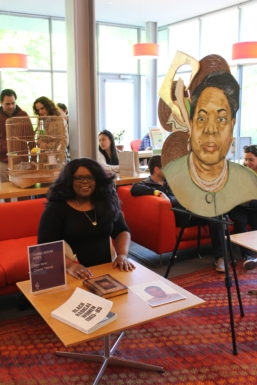
Chanel Thervil in the Living Room of the Gardner Museum with the display of objects she presented to the public. Image courtesy of the artist.
Words can’t describe how much I loved her. And yet, it is in remembering her that I start to see the woman behind the veil of the title Grandma: deeply loving, stubborn and opinionated. She was also a mother, widow, entrepreneur, and avid church-goer who happened to be an immigrant that couldn’t read or write in English. Occasionally my thoughts of her are plagued with irritation aimed at the people who acted as though her Haitian accent was an affliction to their ears. At stores and doctor’s appointments I took turns with my mom acting as her translator, bridging the gap between where Creole danced and English sat frumpy on the corner of her tongue. While my ability to speak Creole had never been as strong as I wanted it to be, I double checked with my Grandma to ensure that the connotation was always right—even if the words weren’t. Our love for each other transcended subject-verb agreements, and I’d like to think the artwork I created as a tribute to her articulates that.
The inquiry from the woman at the museum still lingers in my mind, simultaneously leaving me feeling amused and perplexed. Deeming ordinary people worthy of depiction should not be a radical concept. Just as treating immigrants with dignity that any human deserves shouldn’t be either.
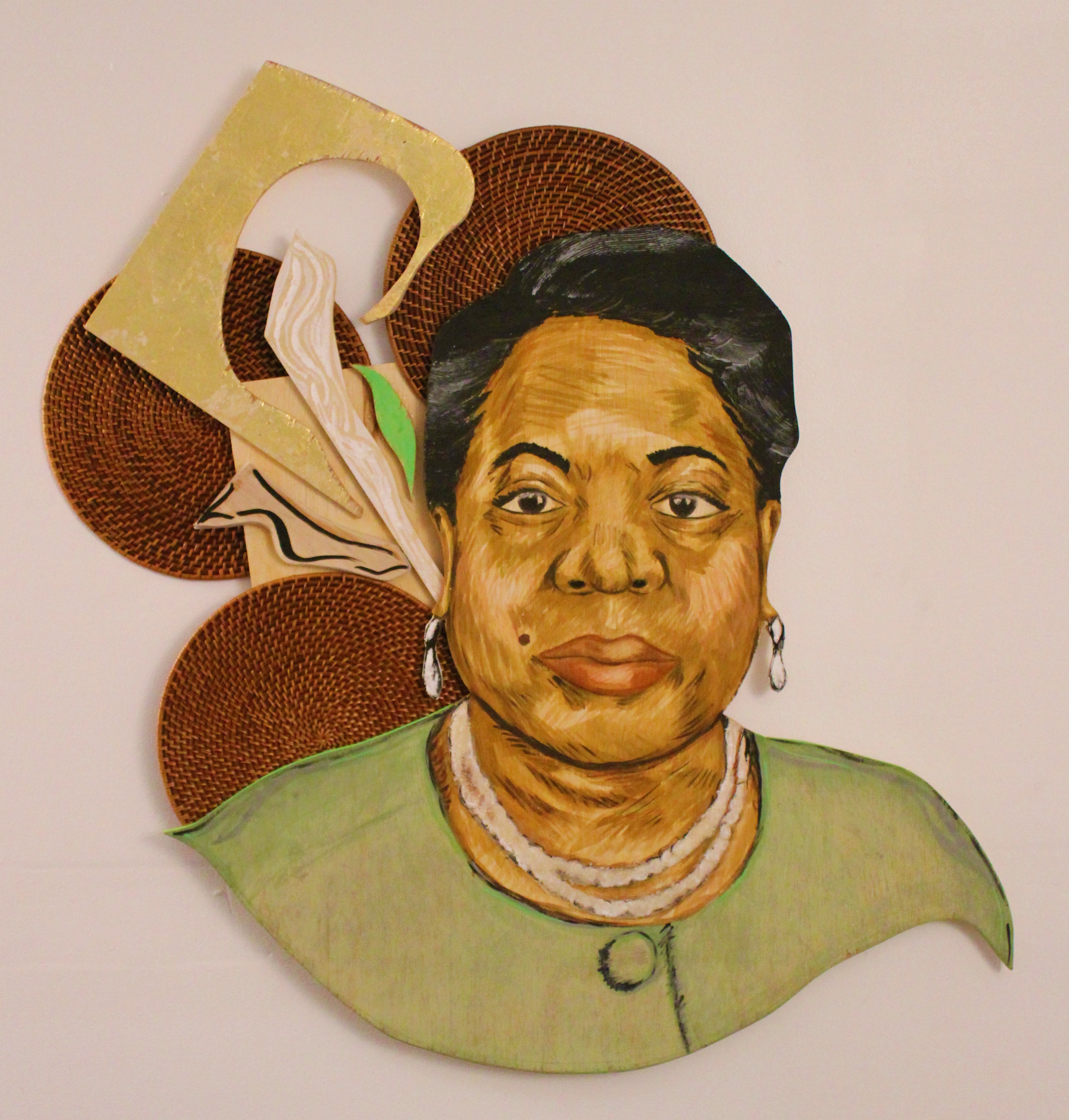
Chanel Thervil, "Dignity: The Image of My Immigrant Grandmother to Remember," 2017, wood, rattan, vellum, salt, gold leaf, acrylic, chalk pastel, 43 x 36 inches, Image courtesy of the artist.
Upon thinking about our nation’s history with monuments, trying to absorb the Trump administration's latest assault on immigrants, and making my work, I have found myself grappling with the following questions left unanswered:
At what point does one become American enough to transcend being an immigrant?
What differentiates ordinary people from those worthy of being remembered?
Where should the responsibility of remembrance of events/places/people lie?
What systems can be put in place to ensure that remembrance has accurate connotations?
- Chanel Thervil in the Living Room of the Gardner Museum with the display of objects she presented to the public. Image courtesy of the artist.
- I started out projecting my Grandmother’s greencard image and rendering her in pencil. Image courtesy of the artist.
- The jigsaw is my tool of choice for getting all of the rounded contours. Image courtesy of the artist.
- Blowing away the sawdust so I can see the lines of the drawing I need to cut along. Image courtesy of the artist.
- Post cutting and sanding, she’s looking good. Image courtesy of the artist.
- I’ve got all the good stuff at the table (materials and reference image) to bring the portrait to life. Image courtesy of the artist.
- Chanel Thervil, “Dignity: The Image of My Immigrant Grandmother to Remember,” 2017, wood, rattan, vellum, salt, gold leaf, acrylic, chalk pastel, 43 x 36 inches, Image courtesy of the artist.

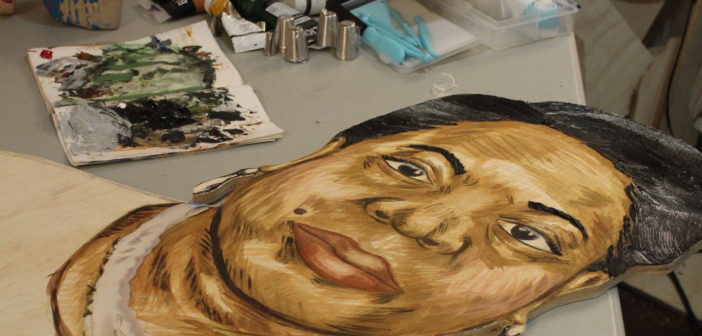
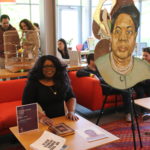
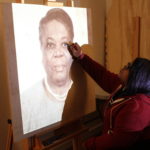
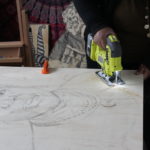
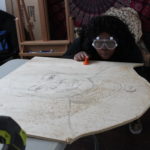
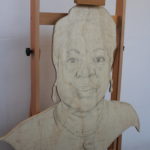
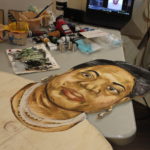
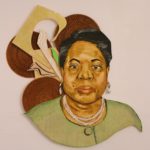

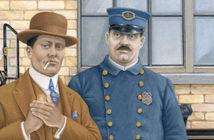
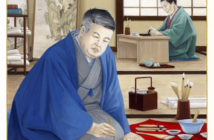
1 Comment
You are soooooo amazing!!!! Your work your vision is love keep being you princess😚
Love you much Uncle
SirPaul